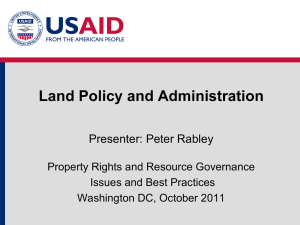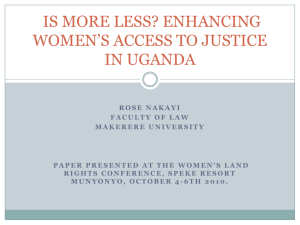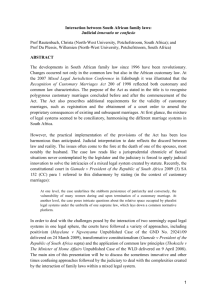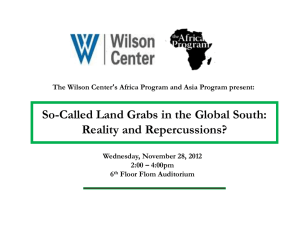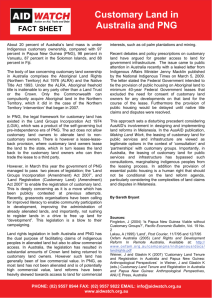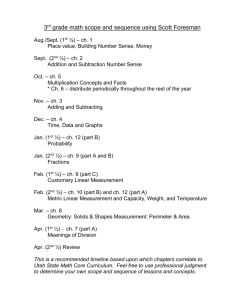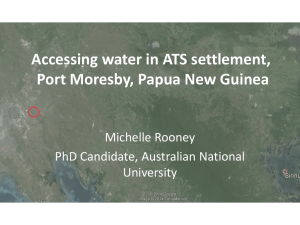The economics of land titling in Papua New Guinea
advertisement
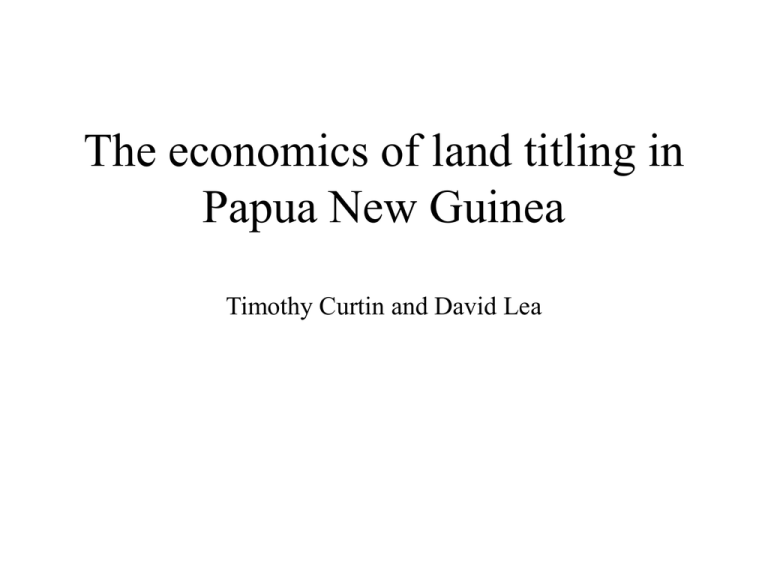
The economics of land titling in Papua New Guinea Timothy Curtin and David Lea Abstract The paper appraises some of the arguments and counter-arguments in the Hughes-Fingleton debate on whether or not customary land tenure is conducive to raising living standards in the South Pacific, with particular reference to Papua New Guinea. The paper shows that both the extent and the productivity of customary individual usufruct title in Papua New Guinea have been greatly exaggerated, and collates some recent empirical evidence on relative productivity of customary and alternative titling modes showing superior outcomes of documented individual land title. Implications for equity and legal/administrative issues conclude the paper. Tenure & development Steven Gosarevski, Helen Hughes and Susan Windybank (2004) (hereafter cited Hughes as the senior author) stirred a hornet's nest by asserting "communal ownership has not permitted any country to develop. In Papua New Guinea, where 90 per cent of people live on the land, it is the principal cause of poverty" (Hughes 2004:137). Jim Fingleton answered with edited papers by Michael Bourke, Mark Mosko, Charles Lightfoot, and R.J. Fisher to expose as "demonstrably false the argument that customary land tenures are an impassable barrier to development". “Communal” Hughes wrong, “customary” Fingleton right But at the same time the reality in the South Pacific island states today, just as in Europe before about 1800, is that while much land is in many practical respects other than alienability of ownership held individually, very large tracts, as much as 77 per cent in Papua New Guinea (and quite large areas in Solomon Islands, Fiji and Vanuata, see Table 1), are indeed held communally in the Hughes sense, namely "land to which members of a community have open, undifferentiated access - something like 'the commons' in England before the Agricultural Revolution" Most land in PNG not held customarily Perception that "97 per cent of land in Papua New Guinea is subject to customary tenure" with the balance of barely 3 per cent land that was alienated during the colonial era. But this is a myth, as shown when Papua New Guinea’s parliament in 2005 enacted amendments to the Forestry Act 1991 which had already curtailed putative exclusively customary claims to natural forest. The amendments formally established that there is no customary title over most of the natural forests that cover around 77 per cent of the country's total land area. Forestry Act Amendments in 2005 The Amendents repealed Section 59 and reworded part of Section 57. There is now no provision for “consultation with” or “obtaining of consent of customary owners” in relation to the intentions of the Forest Authority Board to enter into a Forestry Management Agreement. Had the Amendments legislated away customary owners' rights over their own homes and gardens there would of course have been an uproar, but the Forestry Act amendments aroused very little opposition other than Amet's critical comments (see Appendix I below), precisely because they did not in fact touch on any customary rights. “rubbish land” In effect the Forestry Act Amendments reflect the tenuous claims of tribal groups in parts of Papua New Guinea such as the Southern Highlands province to what many describe as "rubbish land“, i.e. the deep forest. That is not wholly a free for all common land, as it was evidently subject to contest by all and sundry as soon as the Kutubu oilfield was developed in that province (Koyama 2005). But equally there was no established customary individual usufruct. PNG Forests can be characterized as a Commons Thus just as Hughes was wrong to ignore the individual usufructs enjoyed by rural Papua New Guineans in their homes and gardens, Fingleton equally wrongly overlooks the reality that most of the country's land is indeed available for "undifferentiated access" by all and sundry, in the sense that no individuals have uncontestable rights of exclusive access. This lack of differentiable access does much to explain the relative ease with which foreign logging firms have been able to appropriate significant areas merely by playing one group of putative owners against another. [1] Table 1 Natural Forest Areas Millions hectares Total Natural Area Forests PNG 46.9 36.4 Sol Islands 2.8 2.4 Fiji 1.8 0.88 Vanuatu 1.2 0.43 % 77.61 85.71 48.89 35.83 Strata title a modern form of customary? Fingleton explains that customary land tenure is neither individual nor group holding but has elements of both, just as 'individual' tenure in all modern cities from New York to Shanghai, including Sydney and even Port Moresby, for the majority of residents usually combines individual 'strata title' ownership of dwellings in high rise apartment blocks with group ownership of the building itself and its amenities in the form of the 'body corporate', of which unit owners are members and to which they pay charges for common services and maintenance. Malinowski and corporate titles… Fingleton (2005: p.ix) mentions Bronislaw Malinowski’s remark denying the communal nature of customary tenure, comparing the organization to a modern joint stock venture. Some argue along these lines that corporate bodies could be instituted with legally enforceable fiduciary duties to manage landowners' property for their benefit, without disturbing the customary nature of land ownership. Once a duly constituted corporate body has assumed this responsibility, the management of the corporation as agents of the landowners, would not need to realize an unworkable landowner consensus for every decision contemplated. Customary groups, shareholders and ILGs That customary ownership already embodies the salient features of a corporate body is quite misleading. Individual members of corporations have both explicit and implicit rights and their shareholdings in the corporate enterprise have a precise monetary value. This means that individual interests can be bought and sold without reference to the group or a group consensus, and importantly without disposing of corporate assets. That is generally not possible in Papua New Guinea’s ILGs. ILGs and Corporations An alternative model to the ILG envisions the corporation as offering an umbrella that allows private parties to contract with one another more efficiently by limiting the transaction costs. The law in effect offers a standardized form of contract or a set of default rules that facilitate private ordering. This legal entity allows those with money and resources to contract with those of managerial skill but little money, to forge a mutually advantageous cooperative enterprise. Value of alienation Interests held in a corporate enterprise are alienable, which is not the case in customary tenure (or ILGs), in part because contractual relations are voluntary and one can contract out by selling shares. The introduction of the share market represented a significant breakthrough, which allowed for flows of capital to corporations. This significantly increased the value of the shares, because they became capable of being transacted and therefore assets with identifiable and meaningful economic value (De Soto 2000). The possibility of alienation also offers landowners the option of disposing of their interest in the land, (i.e. shares in the corporation) by selling their entitled share to the residual cash flow. Alienation as empowerment? …. This would offer customary landowners a significant degree of control over their land interest because they now have the option of either holding on to their interest in the hope that a future residual cash flow is realized or selling the interest for an immediate gain. In the latter instance they may decide to dispose of their interest rather than risk the possibility that the corporate exercise never realizes a profit or that the profits are misappropriated by a self interested management (not an uncommon occurrence everywhere in the world). ….or dispossession? Is land titling the road to dispossession in which South Pacific landowners like Esau sell their patrimony for a pottage, and we then have starving landless citizens reduced to an impoverished mass, alienated from their traditional lands and huddling around garbage dumps in some huge future Melanesian Manila? But this is already happening around Port Moresby, Lae, and elsewhere, albeit on a proportionately smaller basis because of the relatively small population, despite continuing customary land tenure. Usufruct already provides the basis for entitlement As R. G. Ward (1992: 30) has pointed out, housing sites and gardens, constructed terraces, associated water reticulation systems, compost mounds for sweet potato production, raised beds for taro, drained swamps, for example, already possess the features of individual tenure and entitlement (and we believe, can easily be converted to the “fee simple”). Titling precondition/irrelevant for sociodevelopment? Fingleton himself denies that most land in Papua New Guinea is indeed held communally in an even more primitive sense than the way the 'commons' were held in say Great Britain before completion of the enclosure movement around 1800. Almost the entirety of PNG’s forests is 'owned' communally in exactly the sense used by Hughes, namely that while everybody for miles around claims ownership of any given forest area, not a single individual has any individual usufruct rights, i.e. exclusive rights to ownership of any part of the produce of the primeval forested area.[1] E.g Rural Development Handbook (Hanson 2001: 51) states that over half of Central Province is "unoccupied", and that much of the rest of the province has fewer than 20 per sons per sq. kilometre. [1] There are parts of forested areas in Papua New Guinea (such as the Ramu Valley) where small groups live and cultivate sago with full usufruct rights over the output of these stands, but they have no exclusive individual rights over the 'indigenous' (i.e. unplanted) timber surrounding these stands (personal communication from P. Swadling, 2005). Compensation vs titling and rent The unoccupied areas cannot be said to be subject to 'customary title', although any attempt to construct any infrastructure, whether microwave repeater stations atop mountains as high as 4,000 metres, or water supply for Port Moresby, attracts claimants for 'compensation' from nearly the whole population of the province on the grounds that they all do indeed have title to the mountain peak or river in question. Then there is the agitation every other year for more “compensation” to be paid to the “owners” of the Surinumu Dam, main source of power and water for Port Moresby. Would it not have been better if these owners had had documented title which had then been either sold or commuted for annual rentals? Alternative tenures and agricultural productivity Michael Bourke disputes economic benefits are greater from freehold than customary ownership by arguing that the plantation sector in Papua New Guinea, where production takes place on alienated land, has performed poorly since 1980, especially for coffee, cocoa, copra and rubber. He then claims domestically marketed food, betel nut, vanilla, coffee, cocoa, copra and rubber produced on customary land show the fastest growing agricultural production. Even so, his Table 2 shows that the growth rates of customary smallholders' production of export crops (chiefly coffee, cocoa and copra oil) are well below the population growth rate if that is 2.5 per cent p.a. in Papua New Guinea between 1980 and 2000. Titling, food production and poverty Only palm oil production of which at least two-thirds takes place on the plantations' alienated land has grown more rapidly than the population. Bourke also claims "the volume of energy food is adequate..." Yet Allen, Bourke, and Gibson (2005) endorse Gibson's claim (2000) that in 1996 "40 per cent of Papua New Guineans [were] living in poverty", defined as not achieving food energy consumption of Gibson's minimum of 2250 calories per day per person. Moreover the declines in plantation production cited by Bourke are not a result of the alienated form of land tenure, as most of the owners were either bought out or expropriated (as in Bougainville in 1988). Fig. 1 Cash crop exports and population growth 1980-2000 (1980=100) 1200 1000 Palm oil 800 600 Logs 400 200 0 1980 1981 1982 1983 1984 1985 1986 1987 1988 1989 1990 1991 1992 1993 1994 1995 1996 1997 1998 1999 2000 2001 2002 2003 2004 COCOA COFFEE PALM OIL LOGS COPRA OIL POPULATION Table 2 Are Papua New Guineans poor and starving? Crop Sweet potato Banana Yams Cassava Taro Chinese taro Coconut Sago Potato Rice Total Population Kg per capita Calories per capita per day Australia, kg per capita vegetables 1996 Gibson 2000, Bourke Quantity (t'000)Quantity (t'000) Calories/kg 1286 2872 1144 413 436 1226 143 273 1200 124 272 1295 314 229 1058 227 1000 195 101 3837 83 3313 10 19 750 0.4 3830 2485 4512.4 1,007.92 4400 564.77 2,115.58 150 5200 867.77 2,975.51 162 Table 3 Vegetable production & consumption PNG & Australia Population of PNG Kg per capita Calories per capita per day Australia, kg per capita vegetables Australia's vegetable exports, A$M Australia's vegetable imports, A$M Australia's vegetable production, T - of which potatos - value of potatoes 2004, A$M - unit value, A$/tonne PNG's sweet potatoes in A$M Australia's Veg farms, No. Gross value of production, A$bn 2004 Gibson 1996 4400 564.77 2,115.58 150 472 Bourke 2000 5200 867.77 2,975.51 162 280 245 3,049,891 1,310,800 480.9 366.88 1,054 4400 2.356 ZIMBABWE Fingleton and his team fail to name any country that manages rapid growth without a broad measure of private land titling. They naturally refrain from mentioning Zimbabwe, even though that ought to be their star performer, having abrogated all individual farm land titles since 2000, first by force, and in 2005 by constitutional amendments. This has been widely supported (e.g. Chaumba et al. 2003) because of the perception that expropriating white-owned commercial farms righted the colonial injustice whereby some 6,000 white farmers owned about half of the country's land area allegedly comprising 100 per cent of the best agricultural land. [ Land apportionment 1961 TYPE by soil & climate Acres White Black I II III IV V Total 1,515,000 18,144,700 16,638,600 32,020,200 25,895,000 94,213,500 1,235,000 13,987,000 10,970,000 16,775,000 11,417,000 54,384,000 280,300 4,157,700 5,893,600 15,245,200 14,388,000 39,964,800 White % Whites' of Total by Share of Total Type white by Type 81.52 2.27 77.09 25.72 65.93 20.17 52.39 30.85 44.09 20.99 57.72 100.00 Blacks' Share of Total black by type 0.70 10.40 14.75 38.15 36.00 100.00 Land distribution Such commentators also ignore both the contribution of those few farmers in producing substantial food surpluses consumed by the cities as well as for export and almost all of the country's main export commodity, tobacco, and the failure of the black subsistence farmers in their now nearly 100 per cent of the country to produce any food surplus or crop exports. This lack of performance is not attributable pace Fingleton to anything more than the primitive customary land tenure prevailing in what used to be the "tribal trust lands" and now in practice applicable to 100 per cent of the country's non-urban area, with its concomitant cessation of bank lending for agriculture. A SHOW CASE? Is it too soon to claim Zimbabwe as a showcase for the benefits of extending customary undocumented titling? Agricultural exports plunged from US$850 million in 2000 to around US$350 million in 2005 (according to the IMF) and manufactured exports (mostly based on agriculture) also fell from US$850 million in 2001 to less than US$400 million in 2005. Annual inflation was nearly 600 per cent a year by December 2005, the exchange rate of the Zimbabwe dollar has fallen from Z$8=US$1 in 1999 to Z$150,000 and beyond at February 2006, with up to half of the population stated by international aid agencies to be in urgent need of food aid, all this is in a country that until the invasions of commercial farms from 2000 was a net food exporter. Marx on subsistence farming… Marx had this to say about the powerlessness, and therefore vulnerability, of peasants: "The smallholding peasants form a vast mass, the members of which live in similar conditions but without entering into manifold relations with one another. Their mode of production isolates them from one another instead of bringing them into a mutual intercourse ... Each family is almost selfsufficient; it itself directly produces the major part of its consumption and thus acquires its means of life more through exchange with nature than in intercourse with society. A smallholding, a peasant and his family; alongside them another peasant and another family. A few score of these make up a village, and a few score of villages make up a department ... In so far as millions of families live under economic conditions of existence that separate their mode of life, their interests and their culture from those of the other classes, and put them in a hostile position to the latter, they form a class. In so far as there is merely a local interconnection among these smallholding peasants, and the identity of their interests begets no community, no national bond and no political organisation among them, they do not form a class. They are consequently incapable of enforcing their class interests in their own name, whether through a parliament or through a convention. They cannot represent … and Moeletsi Mbeki on Zimbabwe I owe my quote from Marx to the brother of South Africa’s President, Moeletsi Mbeki. He added: “But who represents the interests of the peasants in Africa today? The answer is nobody. The one African politician who claims to act in the interests of peasants, Zimbabwe's Robert Mugabe, has reduced the once-proud and almost self-sufficient Zimbabwean peasants to paupers who now have to be fed by the United Nations' World Food Programme”. It remains to be seen whether South Africa opts for the Zimbabwe model or that once adopted in Kenya and now being applied gradually in Zambia. Mbeki also commented on the lack of titling in countries like Ethiopia, and World Bank data show that sub-Saharan Africa is alone in the world for its lower food production and GDP per head in 2000 than in 1964. Zambia comparative study of alternative titling models amongst black smallholders in southern Zambia documents greater use of capital for farm development by those with secure titling (see Table 3). Fixed investment included wells, fencing, trees, home improvements, dams and earthworks, borehole, dip tank, in addition to fertilizers and cattle. This provides some contrarian evidence against Fingleton's assertion that there is "little empirical evidence that individual titling results in better access to credit". For those Zambians aspiring to become modern farmers deploying labour-saving machinery and irrigation, loans appear to have been useful, and those making more use of credit enjoyed incomes twice as high as those on undocumented state and customary land. A Table 2 Titling, credit, and income Zambia 2001-2 Total No of farms in sample, southern Zambia Median labour force (aged 12-64) Median farm area, ha Median Area cultivated, ha Mean planted crop areas, ha Maize, hybrid & local, mean % cult area Cotton&sunflower, mean % cult. Area Using fertilizer, % Cattle owned, median Credit use, median, US$ (5-year total) Total crop value/ha p.a., median, US$ Income per capita p.a., median, US$ Total labour force income per HH, US$ Notes: Exchange rate 2001, US$1.00=Kw3,350 No. doc. = no document; reli = relative HHH= Head of Household Source: Robert Smith (2004), Table 1. 266 5 6 3 1 0 54 25 80 36 178 No doc Custom. 103 4 4 2 1 0 41 0 66 17 68 No doc. State 43 5 7 4 1 0 61 6 87 39 195 HHH w/lease 42 6 20 5 1 0 71 5 106 99 51 307 HHH w/title 38 8 42 6 1 0 66 12 60 116 83 666 Tenure & welfare in Zambia The conclusions from Smith's regression analysis are worth quoting: 1. Title holding has an independent positive effect on investment relative to any form on un-documented holding 2. Cattle ownership has an independent relatively strong association with fixed investment (pigs would the comparator in PNG) 3. Title holders have highest total crop value per hectare cultivated and per unit labour applied. 4. Positive link between tenure and welfare outcomes and there are economic costs of tenurial uncertainty in the absence of documentation. 5. "There is still room for land tenure reform on the antipoverty policy agenda" Valuing customary land in PNG I Finally one needs to address the claim that deprivation and dispossession will occur if individual registered freehold is introduced. There is really no necessary connection between the two if all that is contemplated is the registration and alienability of existing customary titles. Anderson (2005) is amongst those who see registration as leading to instant dispossession, and that if titleholders choose to lease their land they will be worse off than if they continued to farm on their own account, because typical rental values for rural land in Papua New Guinea are allegedly only K50 per hectare a year as compared with "average" household subsistence income worth K17,600 p.a. (his Table 1). If those figures are correct it seems unlikely any householder would rush to lease his or her land unless some portion of their holding was surplus to their requirements and/or ability to work it. Valuing customary land in PNG II Anderson's data indicates that in reality the minimum rental payable to the titled householder currently earning an imputed income of K17,600 p.a. from just one hectare would be at least that amount in cash plus a premium for both higher market prices of food previously self-produced and future potential output increases. Even more telling is Anderson's unawareness that his data indicates the minimum purchase price of the hectare of land in question would be K116,000 (i.e. the net present value of an income of K17,600 p.a. for 30 years at the standard company discount rate of 15%). If it is believed that Papua New Guinean landowners would sell themselves short, which has not been the experience of the mining companies since 1989, then it would possible to establish a Land Regulator to adjudicate on prices. Surveying & registration Instead of engaging in linguistic disputes we could all make a more worthwhile contribution if we united to press the Australian government to provide the necessary funding to Papua New Guinea and Solomon Islands to enable their governments to undertake a comprehensive land survey and registration of all titles. Use of the Global Positioning System (GPS) would speed up the surveying exercise, and consideration should be given to establishing a commercial Land Registrar self-funded by levying charges for registration and access to the Register. The British and Kenya governments undertook a similar exercise in Kenya so that by 1977 an area equivalent to 66 per cent of Papua New Guinea's total land area (of which, as noted above, at most half is occupied) had been surveyed and registered with title granted Conclusions In the last analysis much depends on the type of nation state that develops and the quality of government. Governments that exhibit little regard for the common good will no doubt produce societies marked by an impoverished landless peasantry. Equity will be greater when those who progress do so by their own productive efforts rather than by the parasitism of politicians and other rent seekers, whereby most individuals see the high road to wealth and fortune is in government malfeasance. So long as economies fail to offer opportunities for successful entrepreneurial activities based on secure property rights this will continue to be the case. The necessary if not sufficient condition is a more economically viable land tenure system than those prevalent in the South Pacific.
